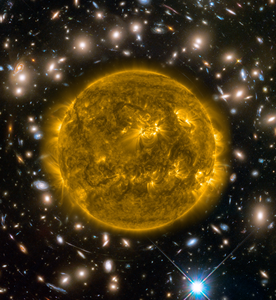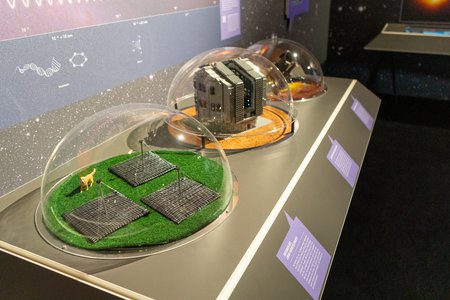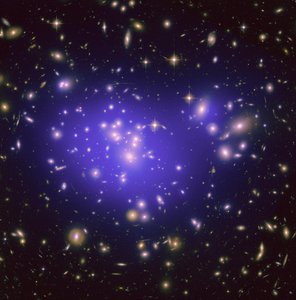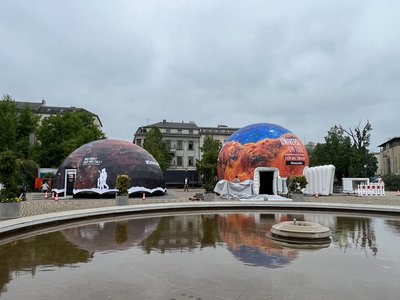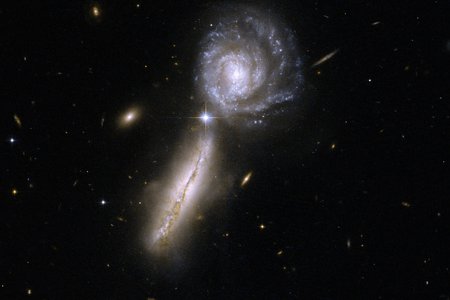Talks on 18th May on the LOFAR radio telescope and galaxy clusters
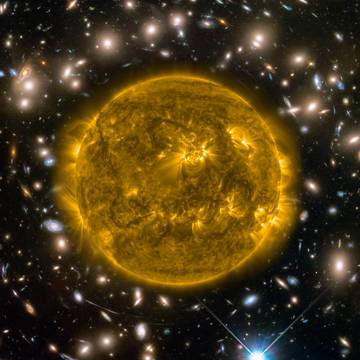
Collage of our star, the sun, and one of the largest structures in the universe, the galaxy cluster Abell 370.
Credit: Sun: NASA/SDO and the AIA, EVE, and HMI science teams; galaxy cluster: NASA, ESA/Hubble, HST Frontier FieldsOn Thursday, 18th May 2023, the Leibniz Institute for Astrophysics Potsdam (AIP) offers two public lectures: a virtual talk on the topic "LOFAR: A next generation radio telescope" will be broadcasted on the YouTube channel "Urknall, Weltall und das Leben" in the virtual Babelsberg Starry Nights series, and a live talk will be given in the mobile planetarium of the "Universe on Tour" roadshow at the Luisenplatz in Potsdam. Please note that both lectures will be given in German.
On Thursday, 18th May, starting at 6 p.m. the lecture of Dr. Christian Vocks on the topic "LOFAR: A next generation radio telescope" from the Babelsberg Starry Nights series will be online. LOFAR is a Europe-wide radio telescope, which consists of quite inconspicuous looking single antennas or antenna fields, which are combined to a radio telescope. One of these antenna fields is located in Potsdam-Bornim. It is used for observing the sun (especially at the AIP), but also for studying other radio sources like pulsars.
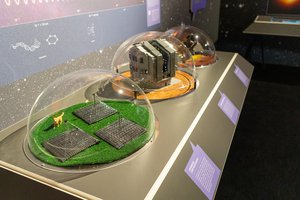
The small model of three antennas of the LOFAR radio telescope (front) is part of the AIP exhibit on board the science ship "MS Wissenschaft".
Credit: AIPBy the way: Currently, a small model of LOFAR antennas is traveling across Germany as part of an exhibit of the AIP on board the MS Wissenschaft. The ship and its interactive exhibit can be found in Berlin until May 22 and in Brandenburg until May 28. Admission is free.
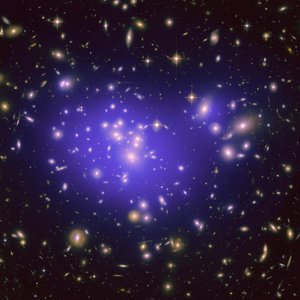
The galaxy cluster Abell 1689 contains dark matter.
Credit: NASA/ESA/JPL-Caltech/Yale/CNRSAt 8 p.m., professor Dr Christoph Pfrommer will give a lecture on "Fascination of galaxy clusters - the largest collapsed objects in the universe" in the mobile planetarium tent of the "Universe on Tour" roadshow. What are the largest objects in the universe and how do they form? And how do you actually weigh cosmological objects? – These are some of the questions which the talk will focus on. Christoph Pfrommer will present various methods used by astrophysicists to weigh galaxy clusters and show that, in addition to galaxies, they consist primarily of dark matter. The question of what dark matter is made of is one of the biggest unsolved problems in physics.
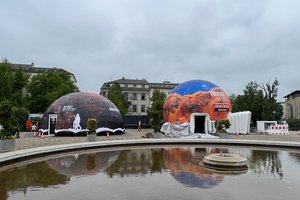
The two tents of the planetarium roadshow have just been set up on the Luisenplatz in Potsdam. Here, professor Christoph Pfrommer will give his public lecture at 8 pm.
Credit: AIP/J. FohlmeisterThe formation of galaxy clusters is not finished, however, since these continue to grow dynamically by mergers with other galaxy clusters. Such collisions of galaxy clusters are among the most energetic events in the universe. Shock waves play an important role in this process, and are also capable of accelerating individual elementary particles to unimaginably large energies and causing entire galaxy clusters to radio-light up. These puzzling processes and other exciting observations of galaxy clusters will be presented, from jellyfish galaxies to cannibalizing galaxies, magnetic mantles to the puzzling connection of super-massive black holes and the hot gas in galaxy clusters.
Please note that both talks will be held in German.
Further information
On the 3rd Thursday of each month from 6 p.m., the Babelsberg Starry Night lectures are available at
https://www.aip.de/babelsberger-sternennaechte
or via the YouTube channel Urknall, Weltall und das Leben (Big bang, the Universe and Life) and can be viewed at any time afterwards.
MS Wissenschaft: https://ms-wissenschaft.de/
Universe on Tour: https://www.wissenschaftsjahr.de/2023/universe-on-tour
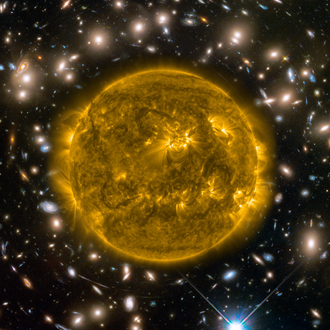
Collage of our star, the sun, and one of the largest structures in the universe, the galaxy cluster Abell 370.
Credit: Sun: NASA/SDO and the AIA, EVE, and HMI science teams; galaxy cluster: NASA, ESA/Hubble, HST Frontier FieldsOn Thursday, 18th May 2023, the Leibniz Institute for Astrophysics Potsdam (AIP) offers two public lectures: a virtual talk on the topic "LOFAR: A next generation radio telescope" will be broadcasted on the YouTube channel "Urknall, Weltall und das Leben" in the virtual Babelsberg Starry Nights series, and a live talk will be given in the mobile planetarium of the "Universe on Tour" roadshow at the Luisenplatz in Potsdam. Please note that both lectures will be given in German.
On Thursday, 18th May, starting at 6 p.m. the lecture of Dr. Christian Vocks on the topic "LOFAR: A next generation radio telescope" from the Babelsberg Starry Nights series will be online. LOFAR is a Europe-wide radio telescope, which consists of quite inconspicuous looking single antennas or antenna fields, which are combined to a radio telescope. One of these antenna fields is located in Potsdam-Bornim. It is used for observing the sun (especially at the AIP), but also for studying other radio sources like pulsars.

The small model of three antennas of the LOFAR radio telescope (front) is part of the AIP exhibit on board the science ship "MS Wissenschaft".
Credit: AIPBy the way: Currently, a small model of LOFAR antennas is traveling across Germany as part of an exhibit of the AIP on board the MS Wissenschaft. The ship and its interactive exhibit can be found in Berlin until May 22 and in Brandenburg until May 28. Admission is free.

The galaxy cluster Abell 1689 contains dark matter.
Credit: NASA/ESA/JPL-Caltech/Yale/CNRSAt 8 p.m., professor Dr Christoph Pfrommer will give a lecture on "Fascination of galaxy clusters - the largest collapsed objects in the universe" in the mobile planetarium tent of the "Universe on Tour" roadshow. What are the largest objects in the universe and how do they form? And how do you actually weigh cosmological objects? – These are some of the questions which the talk will focus on. Christoph Pfrommer will present various methods used by astrophysicists to weigh galaxy clusters and show that, in addition to galaxies, they consist primarily of dark matter. The question of what dark matter is made of is one of the biggest unsolved problems in physics.

The two tents of the planetarium roadshow have just been set up on the Luisenplatz in Potsdam. Here, professor Christoph Pfrommer will give his public lecture at 8 pm.
Credit: AIP/J. FohlmeisterThe formation of galaxy clusters is not finished, however, since these continue to grow dynamically by mergers with other galaxy clusters. Such collisions of galaxy clusters are among the most energetic events in the universe. Shock waves play an important role in this process, and are also capable of accelerating individual elementary particles to unimaginably large energies and causing entire galaxy clusters to radio-light up. These puzzling processes and other exciting observations of galaxy clusters will be presented, from jellyfish galaxies to cannibalizing galaxies, magnetic mantles to the puzzling connection of super-massive black holes and the hot gas in galaxy clusters.
Please note that both talks will be held in German.
Further information
On the 3rd Thursday of each month from 6 p.m., the Babelsberg Starry Night lectures are available at
https://www.aip.de/babelsberger-sternennaechte
or via the YouTube channel Urknall, Weltall und das Leben (Big bang, the Universe and Life) and can be viewed at any time afterwards.
MS Wissenschaft: https://ms-wissenschaft.de/
Universe on Tour: https://www.wissenschaftsjahr.de/2023/universe-on-tour
Images
Collage of our star, the sun, and one of the largest structures in the universe, the galaxy cluster Abell 370.
Big screen size [1000 x 1086, 2.1 MB]
Original size [1388 x 1508, 4.1 MB]
The small model of three antennas of the LOFAR radio telescope (front) is part of the AIP exhibit on board the science ship "MS Wissenschaft".
Big screen size [1000 x 666, 130 KB]
Original size [3000 x 2000, 1.3 MB]
The galaxy cluster Abell 1689 contains dark matter.
Big screen size [1000 x 1012, 130 KB]
Original size [3853 x 3902, 1.4 MB]
The two tents of the planetarium roadshow have just been set up on the Luisenplatz in Potsdam. Here, professor Christoph Pfrommer will give his public lecture at 8 pm.
Big screen size [1000 x 750, 120 KB]
Original size [4032 x 3024, 1.3 MB]
